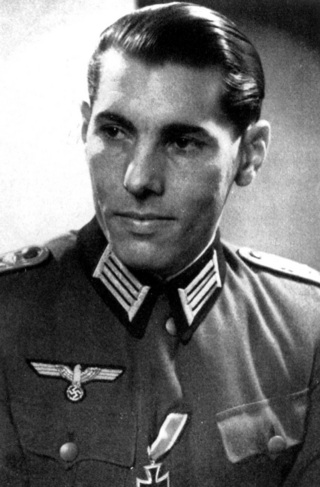Oberstleutnant Robert Bernardis

Personalia
Born:
Died:
Profession:
Curriculum Vitae
Robert Barnardis is born in Innsbruck as the legitimate son of the military master builder Nikolaus Bernardis and Antonia, née Kropik. Robert Bernardis is baptized a Protestant. His father is soon transferred to Linz, and the family moves there as a result. After attending elementary and military secondary schools in Linz and Enns, he and his brother Friedrich graduated from what was then the Federal Educational Institute in Wiener Neustadt in 1925.
He then completed a two-year vocational school in Mödling, from which he graduated as a qualified construction technician. During this time, he joined the Fachstudentische Burschenschaft Wiking zu Mödling, which was founded in 1922. As Robert Bernardis was unable to find a job that matched his training, he initially had to earn his living as a bricklayer and foreman.
In 1928, Robert Bernardis finally went into the military due to the poor situation on the job market 'as many others did - less out of great enthusiasm than out of necessity'. [Note: Robert Barnardis in his handwritten curriculum vitae.]
In keeping with his civilian training, he chose the Pioneer (military) troop at the Officers' Academy in Enns as his branch of arms. As a Matura student, he was able to study there and did not have to complete officer school first.
In 1932, the year he was discharged, he married Hermine Feichtinger, a geography and sports student from Linz. His first troop assignment took him to the Linz Pioneer Battalion 4, where he applied for admission to the 'Higher Officer Courses' in 1936 and was assigned to the 'War Technology Course'. This is a special general staff training course for engineer officers that only exists in the Austrian Armed Forces. This training also contributed significantly to his later close friendship with Claus Schenk Graf von Stauffenberg, as the latter absolutely needed a trained engineer officer for the planned assassination attempt on Hitler.
On March 12, 1938, Robert Bernardis witnessed how the free and independent Austria, to which he had sworn his oath of allegiance, perished with the invasion of the German Wehrmacht. He is incorporated into the German Wehrmacht.
After the German invasion of the Soviet Union on June 22, 1941, the officer, who has since been promoted to third general staff officer (Ic) of the 51st Army Corps (LI.), witnesses mass shootings and cannibalism in a camp near Shitomir, around 140 kilometers west of Kiev. When Robert Bernardis left the camp again, he vomited and did not speak again that day.
When Kharkov was captured at the end of October 1941, Robert Bernardis also witnessed hundreds of inhabitants, mainly Jews, being publicly hanged in the streets. In early 1942, Robert Bernardis fell seriously ill and was first treated in a field hospital in March 1942 and then in a Berlin hospital for duodenal ulcers.
After his recovery, Robert Bernardis rose through the ranks from June 1942 as a lieutenant colonel in the General Staff to become group leader of 'Personnel' in the General Army Office in Berlin's Bendler Block.
When Claus Schenk Graf von Stauffenberg became Chief of Staff of the Reserve Army in September 1943, daily official contact between Robert Bernardis and him was obligatory. It is not possible to prove which of the two was the first to reveal himself to the other on the question of resistance. What is certain is that they quickly reached a consensus on the removal of the National Socialist regime. Robert Bernardis now actively joined the circle of conspirators and, as can be seen from the letters to his wife, initially began to adapt the already existing orders for the Walküre enterprise even more specifically for a Wehrmacht uprising against Hitler in all military circles. As Carl Szokoll later reported, Robert Bernardis made regular trips to Vienna from February 1944. He first visited the Chief of Staff in military district XVII (Vienna), his personal friend, the Knight's Cross recipient Heinrich Kodré. He then informs Captain Carl Szokoll about the status of the preparations for the planned overthrow of the Nazi regime.
On July 20, Heinrich Kodré triggers Walküre, initially bypassing the Commanding General, Hans-Karl Freiherr von Esebeck, and only informing him later about the measures taken. Hans-Karl Freiherr von Esebeck approves them, although he recognizes that the telexes are signed by the long-retired Field Marshal Erwin von Witzleben and are therefore invalid. Only after Robert Bernardis has spoken to Heinrich Kodré for hours does he go to Carl Szokoll to give him the necessary orders for the organization of the Walküre company in the Vienna military district. Carl Szokoll can therefore organize the operation, but is not authorized to initiate it. The order of the military district command is absolutely necessary for this. As Claus Schenk Graf von Stauffenberg's liaison officer between Vienna and Berlin, Robert Bernardis took a considerable risk, as the numerous business trips required for this could hardly be plausibly explained to the Gestapo. After all, Robert Bernardis was the group leader of 'Personnel' and had to organize supplies for the fronts. A personal presence in Vienna is not necessary for this.
On July 20, 1944, it is not possible for General Erich Fellgiebel of the intelligence troops to inform the conspirators in Berlin exactly what is happening. After the assassination attempt, only the SS telephone lines were open, which enabled Adolf Hitler to speak to Major Otto Ernst Remer.
This reveals Robert Bernardis as a member of the conspiracy. The units he alerted immediately followed his orders and dispensed with the prescribed telephone consultation and confirmation by the military district command, because they too were already aware of the real purpose of Bernardis' measures. However, he can only alert the combat units of the military district stationed outside Berlin, as the urban area of Berlin forms a separate command area and is subordinate to Lieutenant General Paul von Hase. In addition, the countermeasures by the guard battalion 'Großdeutschland' under the command of Remer came into effect relatively quickly in the city itself and the conspirators therefore had to reinforce themselves from outside. The Mitte cavalry regiment under the command of Philipp Freiherr von Boeselager was originally intended for this purpose. This was to be transferred from the Brest-Litovsk region to Berlin by transport aircraft. The conspirators expected heavy fighting in the city as a result of the strong SS presence. However, as a result of the system's rapid countermeasures, it was no longer possible to think about transfers to the Berlin area in the late afternoon of July 20, 1944, because the two Berlin airfields could no longer be secured. 'Back to the old holes' - the agreed code word for the failure of the operation transmitted by radio - therefore prompted Philipp Freiherr von Boeselager to quickly move back into his old positions 200 kilometers to the east in order to remain undetected, which he did successfully.
After the failure of the attempted coup, Robert Bernardis' fate was also sealed: He is arrested in the barracks on July 29, 1944.
On August 8, 1944, he is expelled from the Wehrmacht, sentenced to death before the People's Court in Berlin and hanged that very evening in Plötzensee prison, where care is taken to ensure that the condemned die by slow asphyxiation. According to Adolf Hitler, the conspirators should die as painfully as possible and as if in a slaughterhouse, not by firing squad.
Places
Residence:
Honoring:
Memorial:
Citations
Dokumentationsarchiv des österreichischen Widerstands (DÖW)
Wikipedia unter de.wikipedia.org/wiki/Robert_Bernardis
